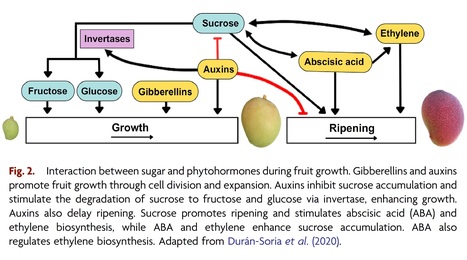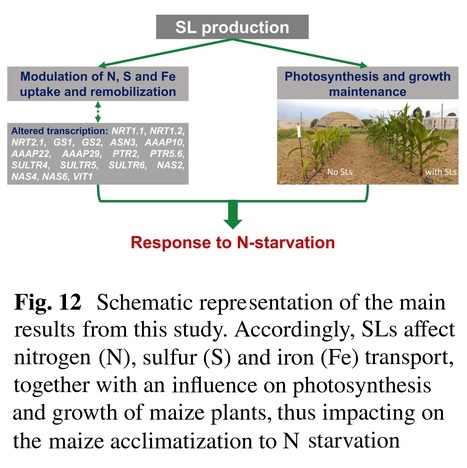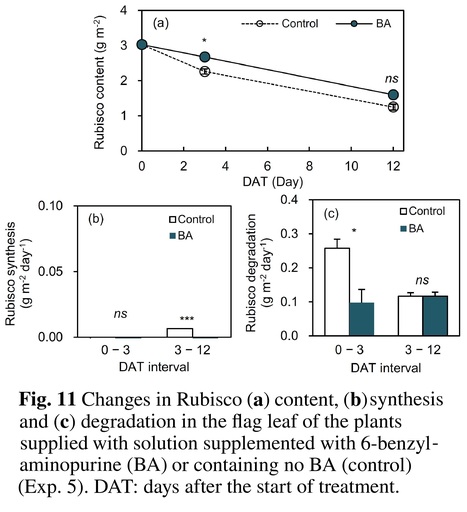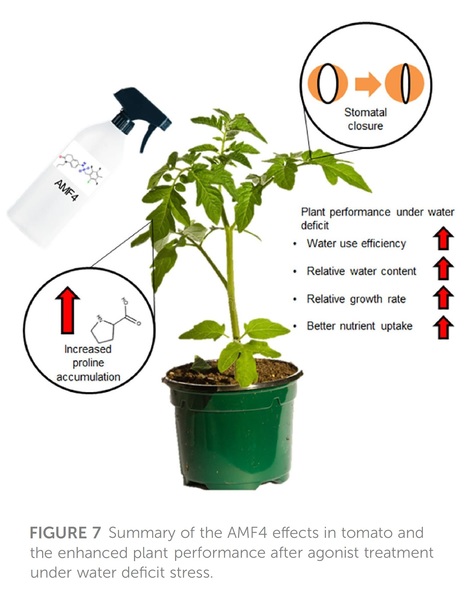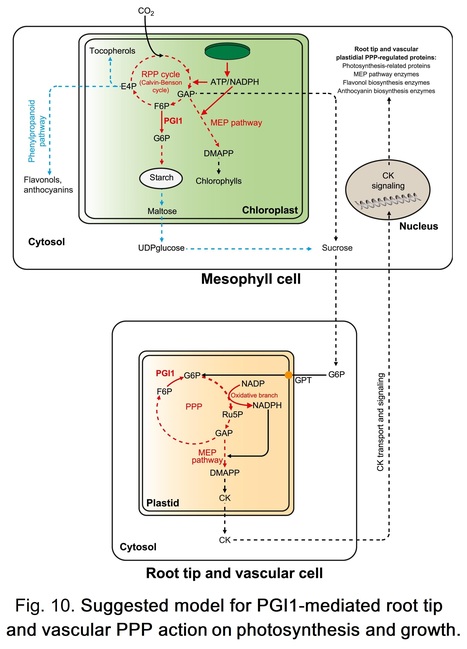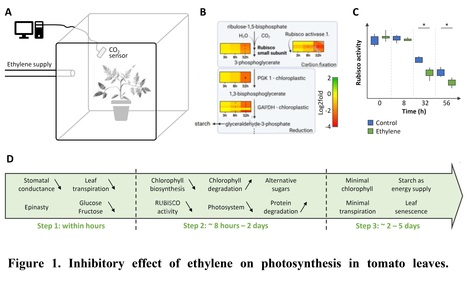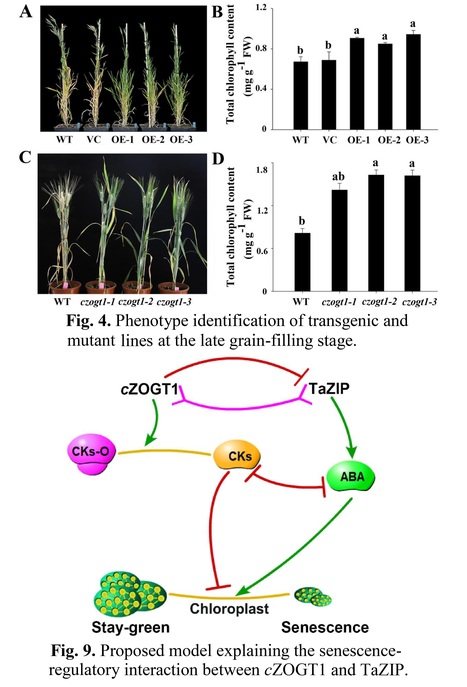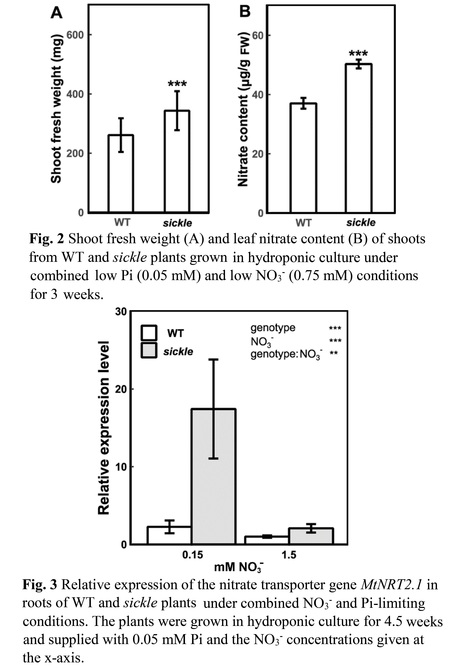Get Started for FREE
Sign up with Facebook Sign up with X
I don't have a Facebook or a X account

 Your new post is loading... Your new post is loading...
 Your new post is loading... Your new post is loading...
From
doi
Authors: Wenzhe Yu, Li Luo, Xiangyu Qi, Yuman Cao, Jie An, Zhiguo Xie, Tianming Hu and Peizhi Yang.
Journal of Agricultural and Food Chemistry (2024) Abstract: "Plant growth-promoting rhizobacteria have been shown to enhance plant tolerance to drought stress through various mechanisms. However, there is limited research on improving drought resistance in alfalfa by genetically modifying PGPR to produce increased levels of cytokinins. Herein, we employed synthetic biology approaches to engineer two novel strains of Sinorhizobium meliloti capable of overproducing trans-Zeatin and investigated their potential in enhancing drought tolerance in alfalfa. Our results demonstrate that alfalfa plants inoculated with these engineered S. meliloti strains exhibited reduced wilting and yellowing while maintaining higher relative water content under drought conditions. The engineered S. meliloti-induced tZ activated the activity of antioxidant enzymes and the accumulation of osmolytes. Additionally, the increased endogenous tZ content in plants alleviated the impact of drought stress on the alfalfa photosynthetic rate. However, under nondrought conditions, inoculation with the engineered S. meliloti strains had no significant effect on alfalfa biomass and nodule formation."
Julio Retamales's insight:
Text of figure above: "Figure 4. Effects of engineered S. meliloti strain and control strain inoculation on the growth performance, leaf morphology, and the reactive oxygen species (ROS) level in leaves of alfalfa. Growth performances before drought treatment (A). Growth performances after drought treatment (B). Leaf morphologies before drought treatment (C). Leaf morphologies after drought treatment (D). Nitroblue tetrazolium (NBT) staining of leaves before drought treatment (E). NBT staining of leaves after drought treatment (F). Diaminobenzidine (DAB) staining of leaves before drought treatment (G). DAB staining of leaves before drought treatment (H). Bar = 1 cm.
Authors: Silvia Quaggiotti, Leonardo Buzzicotti, Karen E. Koch, Jiahn Chou Guan, Sara Trevisan, Serena Varotto, Benedetto Ruperti and Laura Ravazzolo. Plant and Soil (2024) Abstract: "Background and Aims - Nitrogen (N) is an essential macronutrient that can limit plant development and crop yield through widespread physiological and molecular impacts. In maize, N-starvation enhances biosynthesis and exudation of strigolactones (SLs) in a process reversible by nitrate addition and consequent repression of genes for SL biosynthesis. Methods - In the present study, a maize mutant deficient in SL biosynthesis (zmccd8) allowed an in-depth analysis of SL contributions under low N. Both hydroponic and field conditions were used to better characterize the response of the mutant to N availability. Results - The severity of responses to N-limitation by the SL-deficient zmccd8 mutant extended from growth parameters to content of iron, sulfur, protein, and photosynthetic pigments, as well as pronounced impacts on expression of key genes, which could be crucial molecular target for the SL-mediated acclimatation to N shortage. Conclusions - Our results demonstrate that SLs are critical for physiological acclimation to N deficiency by maize and identify central players in this action. Further contributions by iron and sulfur are implicated in the complex pathway underlying SL modulation of responses to N-deprivation, thus widening our knowledge on SL functioning and providing new hints on their potential use in agriculture."
Julio Retamales's insight:
This relevant article can be accessed by using the following link:
Authors: Haiqiang Zhang, Zichen Liu, Yunxiao Wang, Siyu Mu, Hongzhong Yue, Yanjie Luo, Zhengao Zhang, Yuhong Li and Peng Chen. Theoretical and Applied Genetics (2024) Key message A novel super compact mutant, scp-3, was identified using map-based cloning in cucumber. The CsDWF7 gene encoding a delta7 sterol C-5(6) desaturase was the candidate gene of scp-3. Abstract: "Mining dwarf genes is important in understanding stem growth in crops. However, only a small number of dwarf genes have been cloned or characterized. Here, we characterized a cucumber (Cucumis sativus L.) dwarf mutant, super compact 3 (scp-3), which displays shortened internodes and dark green leaves with a wrinkled appearance. The photosynthetic rate of scp-3 is significantly lower than that of the wild type. The dwarf phenotype of scp-3 mutant can be partially rescued by the exogenous brassinolide (BL) application, and the endogenous brassinosteroids (BRs) levels in the scp-3 mutant were significantly lower compared to the wild type. Microscopic examination revealed that the reduced internode length in scp-3 resulted from a decrease in cell size. Genetic analysis showed that the dwarf phenotype of scp-3 was controlled by a single recessive gene. Combined with bulked segregant analysis and map-based cloning strategy, we delimited scp-3 locus into an 82.5 kb region harboring five putative genes, but only one non-synonymous mutation (A to T) was discovered between the mutant and its wild type in this region. This mutation occurred within the second exon of the CsGy4G017510 gene, leading to an amino acid alteration from Leu156 to His156. This gene encodes the CsDWF7 protein, an analog of the Arabidopsis DWF7 protein, which is known to be involved in the biosynthesis of BRs. The CsDWF7 protein was targeted to the cell membrane. In comparison to the wild type, scp-3 exhibited reduced CsDWF7 expression in different tissues. These findings imply that CsDWF7 is essential for both BR biosynthesis as well as growth and development of cucumber plants."
Authors: Petar Mohorović, Batist Geldhof, Kristof Holsteens, Marilien Rinia, Stijn Daems, Timmy Reijnders, Johan Ceusters, Wim Van den Ende and Bram Van de Poel.
Plant Physiology (2024) Abstract: "Ethylene is a volatile plant hormone that regulates many developmental processes and responses towards (a)biotic stress. Studies have shown that high levels of ethylene repress vegetative growth in many important crops, including tomato (Solanum lycopersicum), possibly by inhibiting photosynthesis. We investigated the temporal effects of ethylene on young tomato plants using an automated ethylene gassing system to monitor the physiological, biochemical, and molecular responses through time-course RNA-seq of a photosynthetically active source leaf. We found that ethylene evokes a dose-dependent inhibition of photosynthesis, which can be characterized by three temporally distinct phases. The earliest ethylene responses that marked the first phase and occurred a few hours after the start of the treatment were leaf epinasty and a decline in stomatal conductance, which led to lower light perception and CO2 uptake, respectively, resulting in a rapid decline of soluble sugar levels (glucose, fructose). The second phase of the ethylene effect was marked by low carbohydrate availability, which modulated plant energy metabolism to adapt by using alternative substrates (lipids and proteins) to fuel the TCA cycle. Long-term continuous exposure to ethylene led to the third phase, characterized by starch and chlorophyll breakdown, which further inhibited photosynthesis, leading to premature leaf senescence. To reveal early (3 h) ethylene-dependent regulators of photosynthesis, we performed a ChIP-seq experiment using anti-ETHYLENE INSENSITIVE 3-like 1 (EIL1) antibodies and found several candidate transcriptional regulators. Collectively, our study revealed a temporal sequence of events that led to the inhibition of photosynthesis by ethylene and identified potential transcriptional regulators responsible for this regulation."
Julio Retamales's insight:
Great paper!
Authors: Koji Nakanishi, Hiroko Fujiki, Koichi Ozaki, Satoko Yanahara, Naoko Takeuchi, Yuji Suzuki, Tamiji Sugiyama, Amane Makino, Taiichiro Ookawa and Tadashi Hirasawa. Plant and Soil (2023) Abstract: "Background and Aims - Leaf senescence is accelerated by soil moisture stress during reproductive growth in rainfed paddy rice under drought and in irrigated paddy rice under intermittent irrigation for saving water or mitigating methane emissions. Leaf senescence decreases leaf photosynthetic rate (An) and grain yield. We aimed to elucidate the mechanisms underlying the An decrease under soil moisture stress. Methods - An, leaf content of ribulose-1,5-bisphosphate carboxylase/oxygenase (Rubisco), synthesis and degradation of Rubisco and cytokinin flux from roots were compared between plants grown in moisture-deficient soil (DR-plants) and flooded or wet soil (FL- or WE-plants, respectively) during senescence in pot-grown rice (Oryza sativa L.). Results - The decreases in An and Rubisco content were larger in the DR-plants than in the FL-plants. An was closely correlated with Rubisco content during moisture stress treatment. The larger decrease of Rubisco content in the DR-plants was from increased Rubisco degradation rather than decreased synthesis. The amount of cytokinins transported from roots to shoots was smaller in the DR-plants. The application of 6-benzylaminopurine to leaves of the DR-plants suppressed Rubisco degradation. In a wilty mutant with impaired leaf hydraulic conductance, leaf senescence was significantly higher in the DR-plants than in the FL-plants, although leaf water potential of both groups decreased similarly under sunny conditions. Conclusion - The main cause of an An decrease with senescence in rice under soil moisture stress was the decrease of cytokinin flux from roots to shoots and enhanced Rubisco degradation."
Julio Retamales's insight:
Full title of this relevant article is: "Decrease of cytokinin flux from roots enhances degradation of ribulose-1,5-bisphosphate carboxylase/oxygenase: a mechanism of the accelerated decrease of leaf photosynthesis with senescence under soil moisture stress in rice (Oryza sativa L.)".
Authors: Sompop Pinit, Lalichat Ariyakulkiat and Juthamas Chaiwanon. Scientific Reports (2023) Abstract: "Plant-derived smoke has been shown to promote plant growth and seed germination, but its roles and mechanisms in response to nutrient deficiency stress remain unclear. Plants respond to phosphorus (P) deficiency by undergoing morphological, physiological, and transcriptional changes in order to improve nutrient uptake efficiency. Here, we showed that rice straw-derived smoke water could promote root growth in rice (Oryza sativa cv. Nipponbare) grown under P-sufficient and P-deficient conditions. Transcriptome analysis of the root tissues identified 1309 genes up-regulated and 1311 genes down-regulated by smoke water under P-deficient conditions. The GO terms ‘glutathione transferase activity’ and ‘photosynthesis—light reaction’ were found to be significantly enriched among the genes that were up- and down-regulated by smoke water, respectively. Biochemical analysis showed that smoke water reduced P-deficient-induced accumulation of H2O2 and malondialdehyde (MDA), a lipid peroxidation marker, reduced sucrose contents, but increased Fe accumulation. Furthermore, smoke water suppressed the expression of strigolactone biosynthesis genes, which were strongly induced by P deficiency as an adaptive strategy to improve root P uptake. These results revealed a potential mechanism by which smoke water promotes root growth and interacts with P deficiency-induced transcriptional regulation to mitigate P deficiency stress in rice."
From
doi
Authors: Shufen Wang, Dehai Liu, Tong Jin, Jia Du, Aijuan Tian, Qiang Huang, Maqsood Khan, Shuming Nie, Siwei Zhang, Rui Deng, Mingke Zhang and Xiaofeng Wang.
Scientia Horticulturae (2023) Highlights: • SlBRI1, a core receptor of BR signaling in tomato, is induced by salt stress. • SlBRI1 positively regulates tolerance against high salt concentration mainly through balancing ion homeostasis and activating antioxidant systems. • SlBRI1 promotes germination, biomass accumulation, and enhances yield of tomato exposed to high salt concentrations. Abstract: "Salinity is a key abiotic stress that has a negative impact on overall growth and crop yield. SlBRI1, a major receptor of brassinosteroid (BR) signaling, regulates plant growth and development as well as stress resistance. However, the role of SlBRI1 in salt stress adaptation remains unclear. In this study, we investigated the biological function of SlBRI1 in tomato subjected to high salt concentrations. Our results indicated that SlBRI1 was induced by salt stress. Compared with wild-type plants, SlBRI1 overexpressing lines with enhanced BR signaling showed improved tolerance, while the tomato BR-insensitive mutant cu3−abs1, a loss-of-function mutant of SlBRI1, showed increased sensitivity to high salt concentrations. Physiological analyses indicated that SlBRI1-overexpressing lines have enhanced salt tolerance through elevated cell membrane integrity, higher osmo-protectant accumulation, improved photosynthetic capacity, elevated antioxidant activity, enhanced Na+/K+ homeostasis, and upregulation of stress-related genes. Furthermore, tomato SlBRI1-overexpressing lines exhibited a higher germination percentage, plant height, seedling fresh and dry weight, fruit number per plant, single fruit weight, total soluble solids, and fruit yield per plant than wild-type plants subjected to salt stress. Our research provides evidence indicating the positive role of SlBRI1 in the regulation of salt stress tolerance in tomato and provides new insights for breeding high-yielding crops for saline soil."
From
doi
Authors: Stefan Kircher and Peter Schopfer.
Current Biology (2023) Editor's view: Kircher and Schopfer show that photosynthetic sucrose produced in the leaves acts as phloem-mobile signal controlling lateral root formation and root elongation in a synchronized manner. These results provide an outline of the molecular pathway through which light affects photomorphogenesis in plant parts that are not directly reached by effective light. Highlights • Photomorphogenic and photosynthetic photoreceptors are involved in light signaling • Photosynthetic sucrose, not auxin or HY5 protein, acts as a shoot-to-root signal • Sucrose-induced auxin biosynthesis in the root tip drives the lateral root clock • Auxin controlling lateral root formation is synthesized from tryptophan Abstract: "The development of plant roots is subject to control by light. Here, we show that, similar to monotonous root elongation, the periodic induction of lateral roots (LRs) depends on the activation by light of photomorphogenic and photosynthetic photoreceptors in the shoot in a hierarchical order. The prevailing belief is that the plant hormone auxin serves as a mobile signal transmitter, responsible for interorgan communication, including light-controlled shoot-to-root connections. Alternatively, it has been proposed that the transcription factor HY5 assumes the role as a mobile shoot-to-root signal transmitter. Here, we provide evidence that photosynthetic sucrose produced in the shoot acts as the long-distance signal carrier regulating the local, tryptophan-based biosynthesis of auxin in the LR generation zone of the primary root tip, where the LR clock controls the pace of LR initiation in an auxin-tunable manner. Synchronization of LR formation with primary root elongation allows the adjustment of overall root growth to the photosynthetic performance of the shoot and the maintenance of a constant LR density during light-dark changes in a variable light environment."
Julio Retamales's insight:
Major breakthrough! Sorry: It should have been posted a couple of months ago....
From
phys
In: Phys.org Excerpts: "Exposing seedlings to ethylene in darkness increases size and vigor, in a finding with implications for agriculture. Farmers have worked to increase crop yields for millennia, and the quest remains urgent as the human population continues to grow. Increases in yield often come at a price, however: reductions in stress tolerance." "However, the authors found that when seedlings treated with ethylene in the dark for several days were subsequently given light (and had the ethylene treatment discontinued), the seedlings did better than controls, showing longer primary and lateral roots, a higher density of lateral roots, and an increase in aerial tissue fresh weight. The study is published in the journal PNAS Nexus." "In addition, experiments showed that plants treated with ethylene during darkness were more tolerant of extreme heat, salty soil, and low oxygen levels than controls. The results suggest that ethylene treatments could help improve yields across a range of crops without sacrificing stress tolerance, according to the authors."
Julio Retamales's insight:
Commentary on the outstanding article by Brenya et al. ("Ethylene-mediated metabolic priming increases photosynthesis and metabolism to enhance plant growth and stress tolerance") which is also posted here.
Authors: David Jiménez-Arias, Sarai Morales-Sierra, Emma Suárez, Jorge Lozano-Juste, Alberto Coego, Juan C. Estevez, Andrés A. Borges and Pedro L. Rodriguez. Frontiers in Plant Science (2023) Abstract: "Water deficit represents a serious limitation for agriculture and both genetic and chemical approaches are being used to cope with this stress and maintain plant yield. Next-generation agrochemicals that control stomatal aperture are promising for controlling water use efficiency. For example, chemical control of abscisic acid (ABA) signaling through ABA-receptor agonists is a powerful method to activate plant adaptation to water deficit. Such agonists are molecules able to bind and activate ABA receptors and, although their development has experienced significant advances in the last decade, few translational studies have been performed in crops. Here, we describe protection by the ABA mimic-fluorine derivative 4 (AMF4) agonist of the vegetative growth in tomato plants subjected to water restriction. Photosynthesis in mock-treated plants is markedly impaired under water deficit conditions, whereas AMF4 treatment notably improves CO2 assimilation, the relative plant water content and growth. As expected for an antitranspirant molecule, AMF4 treatment diminishes stomatal conductance and transpiration in the first phase of the experiment; however, when photosynthesis declines in mock-treated plants as stress persists, higher photosynthetic and transpiration parameters are recorded in agonist-treated plants. Additionally, AMF4 increases proline levels over those achieved in mock-treated plants in response to water deficit. Thus water deficit and AMF4 cooperate to upregulate P5CS1 through both ABA-independent and ABA-dependent pathways, and therefore, higher proline levels are produced Finally, analysis of macronutrients reveals higher levels of Ca, K and Mg in AMF4- compared to mock-treated plants subjected to water deficit. Overall, these physiological analyses reveal a protective effect of AMF4 over photosynthesis under water deficit and enhanced water use efficiency after agonist treatment. In summary, AMF4 treatment is a promising approach for farmers to protect the vegetative growth of tomatoes under water deficit stress.
Julio Retamales's insight:
Full title of the article is: "Abscisic acid mimic-fluorine derivative 4 alleviates water deficit stress by regulating ABA-responsive genes, proline accumulation, CO2 assimilation, water use efficiency and better nutrient uptake in tomato plants".
Authors: Yangyang Li, Yang Liu, Zhenhua Gao, Feng Wang, Tao Xu, Mingfang Qi, Yufeng Liu and Tianlai Li. Frontiers in Plant Biology (2023) Abstract: "MicroRNAs (miRNAs) mediate the degradation of target mRNA and inhibit mRNA translation to regulate gene expression at the transcriptional and post-transcriptional levels in response to environmental stress in plants. We characterized the post-transcriptional mechanism by deep sequencing small RNA (sRNA) to examine how miRNAs were involved in low night temperature (LNT) stress in tomato and whether the molecular mechanism depended on the abscisic acid (ABA) signaling pathway. We annotated conserved miRNAs and novel miRNAs with four sRNA libraries composed of wild-type (WT) tomato plants and ABA-deficient mutant (sit) plants under normal growth and LNT stress conditions. Reverse genetics analysis suggested that miR162 participated in LNT resistance and the ABA-dependent signaling pathway in tomato. miR162-overexpressing (pRI-miR162) and miR162-silenced (pRNAi-miR162) transgenic tomato plants were generated to evaluate miR162 functions in response to LNT stress. miR162 deficiency exhibited high photosynthetic capacity and regulated stomatal opening, suggesting negative regulation of miR162 in the ABA-dependent signaling pathway in response to LNT stress. As feedback regulation, miR162 positively regulated ABA to maintain homeostasis of tomato under diverse abiotic stresses. The mRNA of DICER-LIKE1 (DCL1) was targeted by miR162, and miR162 inhibited DCL1 cleavage in LNT response, including the regulation of miRNA160/164/171a and their targets. The DCL1-deficient mutants (dcl1) with CRISPR/Cas9 prevented stomatal opening to influence photosynthesis in the ABA signaling pathway under LNT stress. Finally, we established the regulatory mechanism of ABA-miR162-DCL1, which systematically mediated cold tolerance in tomato. This study suggests that post-transcriptional modulators acted as systemic signal responders via the stress hormone signaling pathway, and the model at the post-transcriptional level presents a new direction for research in plant abiotic stress resistance."
Author: Feu Du.
Molecular Plant (2022) Excerpts: "A recent study by Ye et al. (2022) provided considerable evidence in Arabidopsis that glucose-activated TOR kinase controls the genome-wide histone H3K27me3 levels by phosphorylating and activating a component of the epigenetic machinery." "Through in vivo protein interacting assays, the authors found that TOR specifically interacts with and phosphorylates FERTILIZATION-INDEPENDENT ENDOSPERM (FIE), an essential component of the PRC2 complex. Their studies demonstrated that the phosphorylation of FIE by TOR triggers the translocation of FIE from the cytoplasm to the nucleus (Figure 1)." "Ye et al. (2022) discovered that vernalization-induced glucose accumulation stimulates TOR activity and FIE phosphorylation, thus promoting H3K27me3-mediated silencing of the floral induction repressor gene FLOWERING LOCUS C (FLC). Collectively, the authors identified glucose–TOR–FIE–PRC2 as an important signaling network that transmits nutrient information to direct the remodeling of the chromatin state. This report greatly enhanced our knowledge in understanding how glucose performs as a signal to regulate so many developmental processes in plants."
Julio Retamales's insight:
Commentary on the relevant article by He et al. ("Glucose-driven TOR–FIE–PRC2 signalling controls plant development") in Nature. Such article was already posted here and is to be found at:
|
From
doi
Authors: Muhmmad Asad Ullah Asad, Zhang Yan, Lujian Zhou, Xianyue Guan and Fangmin Cheng.
Plant Physiology and Biochemistry (2024) Highlights: • Sugars play an essential role in the regulations of leaf senescence. • Abiotic stresses trigger sugar signaling by inducing reactive oxygen species burst. • Sugar signaling interact with plant hormones and protein kinase to regulates leaf senescence. • Abiotic stresses target sugar signaling to regulate photosynthesis inhibition and programmed cell death (PCD). Abstract: "Plants have evolved the adaptive capacity to mitigate the negative effect of external adversities at chemical, molecular, cellular, and physiological levels. This capacity is conferred by triggering the coordinated action of internal regulatory factors, in which sugars play an essential role in the regulating chloroplast degradation and leaf senescence under various stresses. In this review, we summarize the recent findings on the senescent-associated changes in carbohydrate metabolism and its relation to chlorophyll degradation, oxidative damage, photosynthesis inhibition, programmed cell death (PCD), and sink-source relation as affected by abiotic stresses. The action of sugar signaling in regulating the initiation and progression of leaf senescence under abiotic stresses involves interactions with various plant hormones, reactive oxygen species (ROS) burst, and protein kinases. This discussion aims to elucidate the complex regulatory network and molecular mechanisms that underline sugar-induced leaf senescence in response to various abiotic stresses. The imperative role of sugar signaling in regulating plant stress responses potentially enables the production of crop plants with modified sugar metabolism. This, in turn, may facilitate the engineering of plants with improved stress responses, optimal life span and higher yield achievement."
Julio Retamales's insight:
Text of figure above: "Fig. 4. Sugar signaling interacts with phytohormones for the regulation of leaf senescence under abiotic stresses. Abiotic stresses interact with SLS by MAX4, MAX3 and MAX1 pathway, while ABA is activated by ABAox3 and NCED1 pathway, and GA is activated by Della protein pathway. ABA accumulation enhances ROS production and regulate starch degradation into sucrose, fructose and glucose thorough SPS and AMX1. Sucrose signals suppress AI and SUT translocate sucrose out of the cell and SWEET translocate it to sinks, HXK1 and ABA regulate ROS burst and enhance electrolyte leak-age and membrane permeability of plasma membrane, and senescence is activated by WRKY and SAGs. The suppressed activity of CRF6 enhances CTKs degradation and reduces CTKs biosynthesis, moreover the reduced CTKs exacerbate the activity of cwINW and nutrient exhaust under stresses."
From
doi
Authors: Ángela María Sánchez-López, Abdellatif Bahaji, Samuel Gámez-Arcas, Nuria De Diego, Ondřej Vrobel, Petr Tarkowski, Edurne Baroja-Fernández, Francisco José Muñoz, Goizeder Almagro, Jose María Seguí-Simarro, Mercedes Tabernero-Mendoza, Lidia López-Serrano, Rafael J.L. Morcillo and Javier Pozueta-Romero.
Plant Physiology and Biochemistry (2024) Highlights: • Vascular plastidial phosphoglucose isomerase (vPGI1) modulates the leaf proteome. • Vascular pentose phosphate pathway (vPPP) activity regulates photosynthesis. • Long-distance interplay between vPPP and photosynthesis in mesophyll cells. • vPGI1-mediated PPP activity modulates the metabolic flux to the MEP pathway. Abstract: "In Arabidopsis, the plastidial isoform of phosphoglucose isomerase, PGI1, mediates growth and photosynthesis, likely due to its involvement in the vascular production of cytokinins (CK). To examine this hypothesis, we characterized pgi1-2 knockout plants impaired in PGI1 and pgi1-2 plants specifically expressing PGI1 in root tips and vascular tissues. Moreover, to investigate whether the phenotype of pgi1-2 plants is due to impairments in the plastidial oxidative pentose phosphate pathway (OPPP) or the glycolytic pathway, we characterized pgl3-1 plants with reduced OPPP and pfk4pfk5 knockout plants impaired in plastidial glycolysis. Compared with wild-type (WT) leaves, pgi1-2 leaves exhibited weaker expression of photosynthesis- and 2-C-methyl-D-erythritol 4-P (MEP) pathway-related proteins, and stronger expression of oxidative stress protection-related enzymes. Consistently, pgi1-2 leaves accumulated lower levels of chlorophyll, and higher levels of tocopherols, flavonols and anthocyanins than the WT. Vascular- and root tip-specific PGI1 expression countered the reduced photosynthesis, low MEP pathway-derived CK content, dwarf phenotype and the metabolic characteristics of pgi1-2 plants, reverting them to WT-like levels. Moreover, pgl3-1, but not pfk4pfk5 plants phenocopied pgi1-2. Histochemical analyses of plants expressing GUS under the control of promoter regions of genes encoding plastidial OPPP enzymes exhibited strong GUS activity in root tips and vascular tissues. Overall, our findings show that root tip and vascular PGI1-mediated plastidial OPPP activity affects photosynthesis and growth through mechanisms involving long-distance modulation of the leaf proteome by MEP pathway-derived CKs."
Julio Retamales's insight:
Relevant article!
Authors: Marieke Dubois
Plant Physiology (2024) Excerpt: "Altogether, the work performed by Mohorović and colleagues revealed the chronology of ethylene-mediated photosynthesis inhibition in young tomato leaves. Their approach defined a three-step response consisting of: (1) a reduction in the capture of CO2 and light, resulting in a rapid decline of soluble sugars, (2) a transcriptional down-regulation of genes related to photosynthesis, coupled to the up-regulation of genes necessary to gather energy from other sources, perhaps sucrose or proteins and (3) a long-term starch and chlorophyll breakdown resulting in leaf senescence (Figure 1D). Adding a time-factor to the extensively studied ethylene response is crucial, as hormones often affect temporary or dynamic processes (Waadt et al., 2022) that can only be detected by time-course experiments, as was elegantly performed in Mohorović et al., 2023. This work paves the way towards further molecular characterization of the regulatory cascades linking the different steps of the ethylene-mediated inhibition of photosynthesis."
Julio Retamales's insight:
Commentary on the relevant article by Mohorović el al. ("Ethylene inhibits photosynthesis via temporally distinct responses in tomato plants"). Such article was already posted here and is to be found at:
From
www
Authors: Ryo Tachibana, Susumu Abe, Momo Marugami, Ayumi Yamagami, Rino Akema, Takao Ohashi, Kaisei Nishida, Shohei Nosaki, Takuya Miyakawa, Masaru Tanokura, Jong-Myong Kim, Motoaki Seki, Takehito Inaba, Minami Matsui, Kentaro Ifuku, Tetsuo Kushiro, Tadao Asami & Takeshi Nakano Nature Communications (2023) Editor's view: The authors identify BPG4, a novel regulator of chloroplast development. BPG4 directly suppresses transcriptional activity of GLK to fine-tune photosynthesis associated nuclear gene expression, and regulates chloroplast development and homeostasis. Abstract: "Chloroplast development adapts to the environment for performing suitable photosynthesis. Brassinosteroids (BRs), plant steroid hormones, have crucial effects on not only plant growth but also chloroplast development. However, the detailed molecular mechanisms of BR signaling in chloroplast development remain unclear. Here, we identify a regulator of chloroplast development, BPG4, involved in light and BR signaling. BPG4 interacts with GOLDEN2-LIKE (GLK) transcription factors that promote the expression of photosynthesis-associated nuclear genes (PhANGs), and suppresses their activities, thereby causing a decrease in the amounts of chlorophylls and the size of light-harvesting complexes. BPG4 expression is induced by BR deficiency and light, and is regulated by the circadian rhythm. BPG4 deficiency causes increased reactive oxygen species (ROS) generation and damage to photosynthetic activity under excessive high-light conditions. Our findings suggest that BPG4 acts as a chloroplast homeostasis factor by fine-tuning the expression of PhANGs, optimizing chloroplast development, and avoiding ROS generation."
Julio Retamales's insight:
Relevant paper!
Authors: Prashanth Tamizhselvan, Sharmila Madhavan, Christian Constan-Aguilar, Eman Ryad Elrefaay, Jie Liu, Aleš Pěnčík, Ondřej Novák, Albert Cairó, Mónika Hrtyan, Markus Geisler and Vanesa Beatriz Tognetti. Plants (2023) Abstract: "Photosynthesis is among the first processes negatively affected by environmental cues and its performance directly determines plant cell fitness and ultimately crop yield. Primarily sites of photosynthesis, chloroplasts are unique sites also for the biosynthesis of precursors of the growth regulator auxin and for sensing environmental stress, but their role in intracellular auxin homeostasis, vital for plant growth and survival in changing environments, remains poorly understood. Here, we identified two ATP-binding cassette (ABC) subfamily B transporters, ABCB28 and ABCB29, which export auxin across the chloroplast envelope to the cytosol in a concerted action in vivo. Moreover, we provide evidence for an auxin biosynthesis pathway in Arabidopsis thaliana chloroplasts. The overexpression of ABCB28 and ABCB29 influenced stomatal regulation and resulted in significantly improved water use efficiency and survival rates during salt and drought stresses. Our results suggest that chloroplast auxin production and transport contribute to stomata regulation for conserving water upon salt stress. ABCB28 and ABCB29 integrate photosynthesis and auxin signals and as such hold great potential to improve the adaptation potential of crops to environmental cues."
Julio Retamales's insight:
Interesting paper
Authors: Yue Song, Donglin Lv, Meng Jiang, Zhiying E, Yifei Han, Yue Sun, Shuijin Zhu, Jinhong Chen and Tianlun Zhao.
Plant Stress (2023) Abstract: "All around the world, salt stress has severely restricted plant development. Cotton is one of the most important cash crops, but the saline soil negatively influences the quality and output of plants. Strigolactones (SLs) is a new type of phytohormone that plays an important role in the development of plants. However, the underlying mechanism of how SLs alleviate the high salinity stress is unclear in cotton. In this research, we observed that exogenous 10 μΜ GR24 (a synthetic analog of SLs) significantly alleviated the salt stress (200 mM NaCl) in the hydroponically planted seedlings. Under salt stress, the contents of proline, O2− malondialdehyde, and hydrogen peroxide were greatly decreased by 48.40%, 45.57%, 31.03%, and 35.52%. Combined with transcriptome analysis and corresponding verification, it was figured out that with the application of exogenous GR24, the genes encoding antioxidant enzymes, chlorophyll biosynthesis, and photosynthesis system were significantly up-regulated, while the activities of antioxidant enzymes, the content of chlorophyll, and the efficiency of photosynthesis were also significantly improved under salt stress in cotton seedlings. Thus, the exogenous application of SLs could enhance the salt tolerance of cotton seedlings, which displayed its great potential for cotton production in salinized land."
Authors: Wenqiang Wang, Gaungqiang Zhang, Wenlong Wang, Zhigang Wang, Yuelin Lv, Fenxia Guo, Yindi Di, Jifa Zhang, Yuhai Wang, Wei Wang, Yuanyuan Li and Qunqun Hao.
Journal of Experimental Botany (2023) Abstract: Premature senescence is an important factor affecting wheat yield and quality. Wheat yield can be increased by delaying senescence and prolonging the effective photosynthetic time. Previously, we found that the cis-Zeatin-O-glucosyltransferase (cZOGT1) gene plays an important role in the stay-green wheat phenotype. In this study, cZOGT1-overexpressing lines exhibited a delayed senescence phenotype, despite a significant reduction in the total cytokinin content. Further, we found that cZOGT1 interacted with TaZIP, and that a high level of cZOGT1 expression led to the suppression of TaZIP expression, which in turn, reduced abscisic acid (ABA) content. The synergistic reduction in cytokinins and ABA levels eventually caused the stay-green phenotype in cZOGT1-OE lines. This study provides a new theoretical basis to explain the mechanism underlying the wheat stay-green phenotype and provides an excellent genetic resource for wheat molecular-design breeding.
Julio Retamales's insight:
Interesting results, particularly as related with the counterintuitive reduced levels of cytokinin....
From
doi
Authors: Shahram Shokrian Hajibehzad, Andrés Romanowski and Ronald Pierik.
Current Biology (2023) Summary: A new study draws attention to photosynthetically produced sucrose as a major shoot-derived and auxin-dependent regulator of root growth and development in plants. Excerpts: "In a recent issue of Current Biology, a study by Kircher and Schopfer5 from the University of Freiburg suggests that sucrose, generated by photosynthesis and transported through the phloem to the root, serves as the core component for light-dependent lateral root formation." "These observations hint at the presence of a signal originating from light and reliant on photoreceptor and/or photosynthesis for regulation of lateral root formation." "Furthermore, they found that supplementing sucrose to the aerial parts of dark-grown seedlings promoted formation of lateral roots (Figure 1). These findings indicate that sucrose is important for lateral root formation and can initiate lateral root formation even in the absence of other potential light cues." "The authors proposed that shoot-derived sucrose may stimulate the conversion of tryptophan into auxin within the root. Indeed, sucrose treatment seems to moderately induce abundance at the root tip of the TAA1 enzyme involved in auxin synthesis from tryptophan, suggesting that sucrose may stimulate local auxin production in the root tip, which might in turn promote lateral root formation (Figure 1)."
Julio Retamales's insight:
Commentary on the relevant article by Kircher and Schopfer ("Photosynthetic sucrose drives the lateral root clock in Arabidopsis seedlings"), which is also posted here.
Authors: Rafael Jorge León Morcillo, Jesús Leal-López, Lidia López-Serrano, Edurne Baroja-Fernández, Samuel Gámez-Arcas, Verónica G. Doblas, Alberto Férez-Gómez and Javier Pozueta-Romero. bioRxiv (2023) Abstract: "RAPID ALKALINIZATION FACTOR (RALF) peptides are important players in regulating cell expansion. In Arabidopsis, volatile compounds (VCs) emitted by the fungal phytopathogen Penicillium aurantiogriseum promote root hair (RH) proliferation and hyper-elongation through ethylene and enhanced photosynthesis signalling actions. A striking alteration in the proteome of fungal VC-treated roots involves up-regulation of RALF22. To test the possible involvement of RALF22 in the fungal VC-promoted RH changes, we characterized RH density and number responses to fungal VCs in ralf22 and fer-4 plants impaired in RALF22 and its receptor FERONIA, respectively. Unlike WT plants, ralf22 and fer-4 RHs responded weakly to fungal VCs, strongly indicating that the RALF22-FERONIA module is a key determinant of the RH response to fungal VCs. To investigate the regulatory mechanisms behind this response, we analysed the RALF22 transcript levels in roots of etr1-3 and eir1 ethylene signalling mutants and those of ethylene-responsive, RH-related RSL4, RHD2, PRX1 and PRX44 transcripts in ralf22 and fer-4 roots. Moreover, we characterized the RH and RALF22 transcript level responses to fungal VCs of the cfbp1 mutant defective in photosynthetic responsiveness to VCs. Unlike in WT roots, fungal VCs weakly enhanced RALF22 expression in etr1-3, eir1 and cfbp1 roots, and RSL4, RHD2, PRX1 and PRX44 expression in ralf22 and fer-4 roots. In addition, fungal VCs weakly promoted RH changes in cfbp1 roots. Collectively, our findings showed that the ethylene and enhanced photosynthesis signalling-mediated RH response to fungal VCs involves RALF22-FERONIA."
Authors: Eric Brenya, Esha Dutta, Brittani Herron, Lauren H. Walden, Daniel M. Roberts and Brad M. Binder.
PNAS Nexus (2023) Significance: The ability of seedlings to transition from darkness to light as they emerge from the soil is critical for plant survival. Here, we demonstrate that ethylene is an important factor early in seedling development that has long-lasting effects on plant growth and tolerance to stresses after they transition from darkness into light. Our study illustrates that transient exposure to ethylene in darkness results in long-term increases in photosynthesis and carbohydrates upon transition to light. These changes lead to increased growth and stress tolerance. This response is likely to be widespread in angiosperms since several angiosperm species show growth enhancement under these conditions. Abstract: "Enhancing crop yields is a major challenge because of an increasing human population, climate change, and reduction in arable land. Here, we demonstrate that long-lasting growth enhancement and increased stress tolerance occur by pretreatment of dark grown Arabidopsis seedlings with ethylene before transitioning into light. Plants treated this way had longer primary roots, more and longer lateral roots, and larger aerial tissue and were more tolerant to high temperature, salt, and recovery from hypoxia stress. We attributed the increase in plant growth and stress tolerance to ethylene-induced photosynthetic-derived sugars because ethylene pretreatment caused a 23% increase in carbon assimilation and increased the levels of glucose (266%), sucrose/trehalose (446%), and starch (87%). Metabolomic and transcriptomic analyses several days posttreatment showed a significant increase in metabolic processes and gene transcripts implicated in cell division, photosynthesis, and carbohydrate metabolism. Because of this large effect on metabolism, we term this “ethylene-mediated metabolic priming.” Reducing photosynthesis with inhibitors or mutants prevented the growth enhancement, but this was partially rescued by exogenous sucrose, implicating sugars in this growth phenomenon. Additionally, ethylene pretreatment increased the levels of CINV1 and CINV2 encoding invertases that hydrolyze sucrose, and cinv1;cinv2 mutants did not respond to ethylene pretreatment with increased growth indicating increased sucrose breakdown is critical for this trait. A model is proposed where ethylene-mediated metabolic priming causes long-term increases in photosynthesis and carbohydrate utilization to increase growth. These responses may be part of the natural development of seedlings as they navigate through the soil to emerge into light."
Julio Retamales's insight:
Major breakthrough!
Authors: Ming Zeng, Nicole M. van Dam and Bettina Hause. Physiologia Plantarum (2023) Abstract: "Ethylene (ET) controls many facets of plant growth and development under abiotic and biotic stresses. MtEIN2, as a critical element of the ET signalling pathway, is essential in biotic interactions. However, the role of MtEIN2 in responding to abiotic stress, such as combined nutrient deficiency, is less known. To assess the role of ethylene signalling in nutrient uptake, we manipulated nitrate (NO3-) and phosphate (Pi) availability for wild type (WT) and the ethylene-insensitive (MtEIN2-defective) mutant, sickle, in Medicago truncatula. We measured leaf biomass and photosynthetic pigments in WT and sickle to identify conditions leading to different responses in both genotypes. Under combined NO3- and Pi deficiency, sickle plants had higher chlorophyll and carotenoid contents than WT plants. Under these conditions, nitrate content and gene expression levels of nitrate transporters were higher in the sickle mutant than in the WT. This led to the conclusion that MtEIN2 is associated with nitrate uptake and the content of photosynthetic pigments under combined Pi and NO3-deficiency in M. truncatula. We conclude that ethylene perception plays a critical role in regulating the nutrient status of plants." Via Jean-Michel Ané
Authors: Martin Hudeček, Vladimíra Nožková, Lucie Plíhalová and Ondřej Plíhal. Frontiers in Plant Science (2023) Abstract: "To cope with biotic and abiotic stress conditions, land plants have evolved several levels of protection, including delicate defense mechanisms to respond to changes in the environment. The benefits of inducible defense responses can be further augmented by defense priming, which allows plants to respond to a mild stimulus faster and more robustly than plants in the naïve (non-primed) state. Priming provides a low-cost protection of agriculturally important plants in a relatively safe and effective manner. Many different organic and inorganic compounds have been successfully tested to induce resistance in plants. Among the plethora of commonly used physicochemical techniques, priming by plant growth regulators (phytohormones and their derivatives) appears to be a viable approach with a wide range of applications. While several classes of plant hormones have been exploited in agriculture with promising results, much less attention has been paid to cytokinin, a major plant hormone involved in many biological processes including the regulation of photosynthesis. Cytokinins have been long known to be involved in the regulation of chlorophyll metabolism, among other functions, and are responsible for delaying the onset of senescence. A comprehensive overview of the possible mechanisms of the cytokinin-primed defense or stress-related responses, especially those related to photosynthesis, should provide better insight into some of the less understood aspects of this important group of plant growth regulators." |



